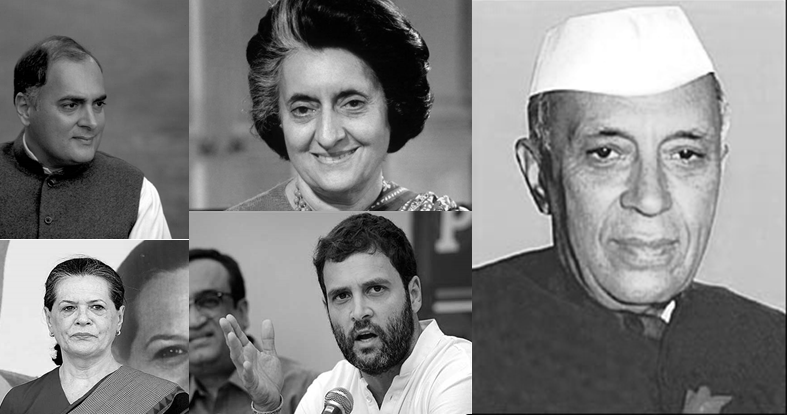In the first essay of this series, we outlined our theory of neo-monarchy and third Indian occupation. We observed that the key to building such an empire in a democratic setup lay in institutionalizing certain mentalities: Exposing the Left Wing Cartel – Chapter 1 | Introduction to their methods. This week, we look at how certain legacies were created courtesy the misuse of governmental institutions. We look at how an entire dynasty survived on these legacies, and built a political behemoth which depended completely on them and their ‘legacies’.
Jawaharlal Nehru – The onset of Gandhi-Nehru Dynasty
India’s first Prime Minister Jawaharlal Nehru built several institutions and gave the country a certain direction. Without getting into the merits and demerits of his contributions, we see signs that alongside institutions he was building a legacy as well. In 1955, Nehru bagged India’s highest civilian award, the Bharat Ratna. The recommendations for this award are made by the prime minister’s office, an office he held himself at the time. Apart from it being a conflict of interests, this comes across as blatant self-promotion. It also ensured that history, or rather the ‘sarkaari’ history books, judged him more positively. The title ‘chacha’ given to him because of his fondness for children also seems like a cornerstone in legacy-creation. Often we come across texts telling us how he worked tirelessly for the welfare of children. What this work was, is never mentioned. One website cites the creation of educational institutions such as AIIMS and IIT, which have nothing to do with children. Many believe that Subhash Chandra Bose, someone who could have been a major political rival of Nehru, died in the hands of the Soviet Union. The Soviet Union was one of Nehru’s closest international allies. Another political opponent, Shyama Prasad Mookerjee, died under dubious circumstances in the hands of the Kashmir government. Lack of political opposition, whether natural or engineered, was one of the reasons why his legacy remained untarnished. We forget our humiliating defeat against China and our detrimental socialism, and remember him as a compassionate statesman and intellectual.
Lal Bahadur Shastri – The Gandhi-Nehru Dynasty branding halts for a bit
Lal Bahadur Shastri, the man who led India after Nehru, ensured Pakistan was defeated in the 1965 war. He ushered in both the green and the white revolution. But he wasn’t one to care much about the Gandhi-Nehru dynasty and its legacy. He died on a visit to Tashkent under dubious circumstances. Nehru’s daughter Indira Gandhi took over, and from then on there was a clear attempt to downplay Shastri’s achievements.
Indira Gandhi – Gandhi-Nehru Dynasty brand building resumes
The transition of power to Indira was quite seamless. After all she was Nehru’s daughter, often seen by his side back in the day. Democracy in its contemporary form was rather new to most people. If dynastic politics is so rampantly accepted today, we can imagine how much at ease people would have been with such a transition back then. In 1971, Indira Gandhi was awarded the Bharat Ratna. The procedure for this award hadn’t changed from her father’s time, so in effect she awarded herself the country’s highest civilian award. The emergency between 1975 and 1977 is the only time the dynasty lost the plot. The mother and son duo of Indira and Sanjay ruled the country as if it was a monarchy, as opposed to an erstwhile neo-monarchy. The government that replaced hers, India’s first non-Congress government, was a failure. The country soon turned back to her. By now, somebody from the family ruling our country had become the status-quo for the Indian psyche. Legacy had made too deep a dent. After she died, she was remembered as a courageous and suave woman under whom we won the Bangladesh war. The emergency and the short-sighted nationalizations were forgotten.
Rajiv Gandhi – Gandhi-Nehru dynasty branding propagates
After she died, her son Rajiv took over. This had become such a routine practice that nobody doubted things would play out in this way. Rajiv presided over the Sikh riots. Under him, communalism dawned a whole new avatar with the Shah Bano affair. Corruption dawned a whole new avatar with the Bofors affair. But what most history books tell us, is that he was the father of India’s telecom revolution.
PV Narasimha Rao – Gandhi-Nehru dynasty branding hits a temporary roadblock
The dynasty made a brief exit after Rajiv’s demise, but was roped in again. The party had realized that its primary means of survival lay in the Gandhi-Nehru dynasty ’s legacy. It became completely subservient to the family, and this sycophancy has been the Congress party’s most important characteristic. An excellent prime minister such as Narasimha Rao could not do to the party what Sonia Gandhi, who wasn’t even of Indian origin, managed to do. She overthrew Atal Bihari Vajpayee, arguably India’s best prime minister, in 2004.
Manmohan Singh – Gandhi-Nehru dynasty branding now spread by a stooge
The dynasty ruled again for ten years, but this time through a stooge. Attempts to keep the legacy alive were made even then. We must remember that image building and the ‘victors writing history’ phenomenon were not the only tools at their disposal. When Manmohan Singh left office, his government and other Congress governments had named 450 different kinds of things after people from the dynasty. This included programs, schemes, institutions, awards, scholarships, tournaments, buildings and roads. The state tried to project this illusion all along, that all benevolence and all excellence in India is associated to that family in some way.
Narendra Modi – Gandhi-Nehru branding and the legacy myth are shattered
